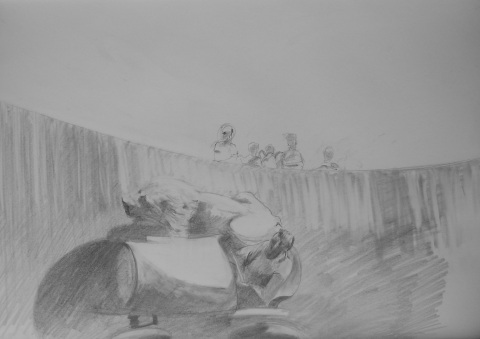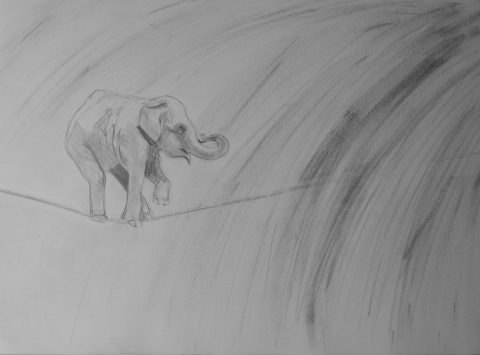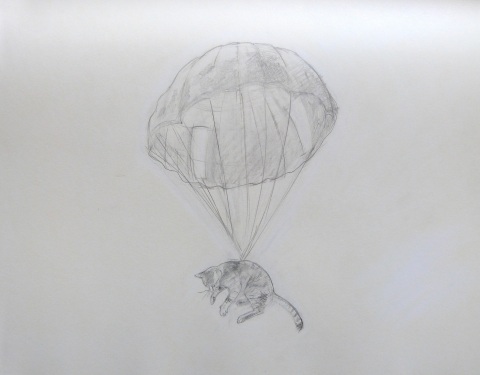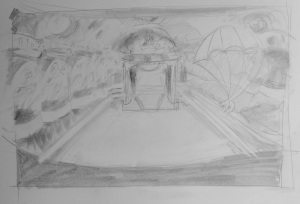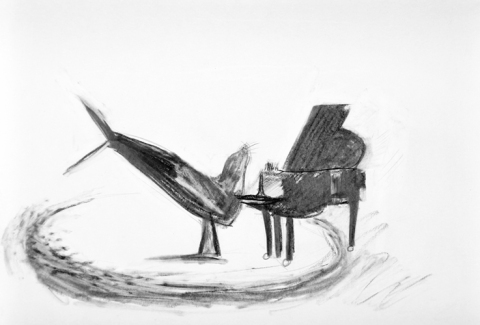Animal Acts | Act 5: Wall of Death (Panthera leo)
November 21, 2013 § Leave a comment
“ROLL UP, ROLL UP! Thrill to the sight of FEARLESS EGBERT and JACK O’MALLEY: COLLIN’S famous death riders and the amazing RACING LION! In our very own SILODROME you will see our death defying dare devils – both human and feline – perform AMAZING feats that will DEFY THE LAWS OF GRAVITY!”
I first heard of a lion riding in a sidecar on the Wall of Death from the artist and curator Dominic Mason about a year or so ago. After a subsequent visit to the National Fairground Archive I discovered that the act was not uncommon during the peak of popularity of the Wall of Death rides in the USA and UK. Since that time I have also had the pleasure of meeting Antony Harris, who had ridden the wall at an early age with his father Elias Harris, one of the original Wall of Death riders from a family of performers whose act included a wall-riding lioness. Apparently the rider carried a loaded pistol in case the lion became a danger to himself or to his audience …
The Wall of Death, motordrome, silodrome or Well of Death (aka “Maut ka Kuaa“, India) is a carnival sideshow featuring a silo- or barrel-shaped wooden cylinder, ranging from 20 to 36 feet (6.1 to 11 m) in diameter, inside of which motorcyclists, or the drivers of miniature automobiles, travel along the vertical wall and perform stunts, held in place by centripetal force. Favouring 1930s ‘American Indian’ motorbikes, Wall of Death riders were stars of the British Fairground, particularly in the North of England. They commanded a loyal fan base, earned clothing sponsorships, and even featured on collectable trading cards. A similar act called the Globe of Death, which originally came to the UK as part of the Wembley Exhibition in 1922, with a subsequent appearance at the British Fair in 1926, has the riders looping inside a wire mesh sphere rather than a drum. This form of motorcycle entertainment had a separate and distinct evolution from carnival motordromes and derived from bicycle acts or “cycle whirls” in the early 1900s.
No one knows who actually invented either show but evidence suggest that the wall existed in the United States of America in the early 1900s with reports having been made of bicycles being used as early as 1908. There is even a suggestion made before 1900 of using bicycles on a type of Wall of Death, not for entertainment but for exercise! The earliest reference of the Wall of Death is the United States in 1928, it having arrived from the United States via Europe. Ned Williams, in his history of Pat Collins, wrote that the 1920s fairground scene roared into the 1930s with the arrival of the Wall of Death.From the 1930s until the early 1970s they enjoyed a period of immense popularity and all of the major fairs would have had at least one Wall of Death as part of the overall attractions. There is no evidence as to when the Globe of Death first appeared but it is generally thought to have been around the same time or possibly even slightly before the wall. Many different stunts were tried – it was quite common for a lion to be taken on the wall in a side car while bears and monkeys would also be featured. The Austin Seven motor car was also adapted for riding on the wall and specially made Go-Karts were, and indeed still are, used.
There are only three Walls of Death in the United Kingdom today, and these are travelled by Graham Crispey, Ken Fox and Allan Ford. A typical performance comprises four or five separate events including straight wall riding, dipping and diving, the rider coming within inches of the safety wire with the rear wheel, a demonstration of Go-Karting, a demonstration of trick riding, and finally the Hell Riders Race, with two or sometimes even three riders on the wall at the same time.
Neil Calladine, National Fairground Archive
In India, the show is also known as the Well of Death (Hindi: मौत का कुआँ, Punjabi: ਮੌਤ ਦਾ ਖੂਹ) and can be seen in the various melas (fairs) held across the country. Apart from motorcycles, the act may also feature other vehicles such as automobiles, as performed regularly in Adilabad in India since 2005. The show involves a temporary cylindrical structure about 25 feet high and 30 feet in diameter, or wider when cars are to be involved, built of hardwood planks. The audience stands upon the platform built around the circumference of the structure and gaze down into the well where the motorcyclists or cars drive.
The lion (Panthera leo) is one of the four big cats in the genus Panthera and a member of the family Felidae. With some males exceeding 250 kg (550 lb) in weight, it is the second-largest living cat after the tiger. Wild lions currently exist in sub-Saharan Africa and in Asia (where an endangered remnant population resides in Gir Forest National Park in India) while other types of lions have disappeared from North Africa and Southwest Asia in historic times. Until the late Pleistocene, about 10,000 years ago, the lion was the most widespread large land mammal after humans. They were found in most of Africa, across Eurasia from western Europe to India, and in the Americas from the Yukon to Peru. The lion is a vulnerable species, having seen a major population decline in its African range of 30–50% per two decades during the second half of the 20th century. Lion populations are untenable outside designated reserves and national parks. Although the cause of the decline is not fully understood, habitat loss and conflicts with humans are currently the greatest causes of concern. Within Africa, the West African lion population is particularly endangered.
Lions live for 10–14 years in the wild, while in captivity they can live longer than 20 years. In the wild, males seldom live longer than 10 years, as injuries sustained from continual fighting with rival males greatly reduce their longevity. They typically inhabit savanna and grassland, although they may take to bush and forest. Lions are unusually social compared to other cats. A pride of lions consists of related females and offspring and a small number of adult males. Groups of female lions typically hunt together, preying mostly on large ungulates. Lions are apex and keystone predators, although they scavenge as opportunity allows. While lions do not typically hunt humans, some have been known to do so. Sleeping mainly during the day, lions are primarily nocturnal, although bordering on crepuscular in nature.
Highly distinctive, the male lion is easily recognised by its mane, and its face is one of the most widely recognised animal symbols in human culture. Depictions have existed from the Upper Paleolithic period, with carvings and paintings from the Lascaux and Chauvet Caves, through virtually all ancient and medieval cultures where they once occurred. It has been extensively depicted in sculptures, in paintings, on national flags, and in contemporary films and literature. Lions have been kept in menageries since the time of the Roman Empire, and have been a key species sought for exhibition in zoos over the world since the late eighteenth century. Zoos are cooperating worldwide in breeding programs for the endangered Asiatic subspecies.
Animal Acts | Act 4: Un éléphant qui se balançait (Elephas maximus indicus)
October 16, 2013 § Leave a comment
“Blondin – the greatest performing elephant in the world – will at 2 and 7 present the most astounding feat of pachyderm funambulism!
An audience of thousands will gather at Niagara Falls tomorrow in order to witness the most astounding feat of bravery and physical prowess ever to be performed by a wild animal. The mighty Indian elephant ‘Blondin’ will be seen to walk the tightrope – a single, tensioned cable spanning the roaring cataract – apparently mindless of any spray that might dampen the wire … even as it bends alarmingly under his weight! In spite of his great mass – and his lumbering gait – ‘Blondin’ will balance across, almost as if taking a casual walk in a city park, perhaps even pausing to bow at mid-point to his admiring and cheering audience!”
The most famous high wire walker was Charles Blondin who crossed the gorge at Niagara Falls seventeen times on a tightrope. Many people tried to emulate this feat. Although a poster exists advertising a Blondin elephant – from Sanger’s Grand National Amphitheatre, Lambeth, 1881 – it is, of course, extremely unlikely that a spectacle such as is described above could ever have taken place in reality. For one thing, elephant funambulists were actually equipped with a double wire.
Even so, these feats of balance must have felt extremely precarious for an animal that might weigh in excess of 5000kg …
The Indian elephant (Elephas maximus indicus) is one of three recognised subspecies of the Asian elephant and native to mainland Asia. Since 1986, Elephas maximus has been listed as Endangered by IUCN as the population has declined by at least 50% over the last three generations, estimated to be 60–75 years. Asian elephants are threatened by habitat loss, degradation and fragmentation.
Elephants were historically kept for display in the menageries of Ancient Egypt, China, Greece and Rome. The Romans in particular pitted them against humans and other animals in gladiator events. In the modern era, elephants have traditionally been a major part of zoos and circuses around the world. In circuses, they are trained to perform tricks. The most famous circus elephant was probably Jumbo (1861 – September 15, 1885), who was a major attraction in the Barnum & Bailey Circus. Asian elephants were always more common than their African counterparts in modern zoos and circuses. After CITES listed the Asian elephant under Appendix I in 1975, the number of African elephants in zoos increased in the 1980s, although the import of Asians continued.
Animal Acts | Act 3: The Baldwin Cat (Felis catus or Felis silvestris catus)
September 3, 2013 § Leave a comment
“The Baldwin Cat is the latest novelty. It walks on to the stage at Day’s Concert Hall, springs at the word of command up a perpendicular rope hanging from the roof, which is calculated to be 44ft long. It then seats itself on a board attached to a parachute, which is fixed to the roof by a string tied in a running knot, and at the words “Let go” the cat pulls the string and the parachute expands and falls slowly to the floor. A large audience witnessed the performance for the first time last night and were highly pleased with it, and a few words which a Mail man had with the trainer, Mr Martin, showed that the intelligence of the cat had not been developed without extraordinary perseverance and patience. The training of the animal was commenced when it was a month old, and at first it was made to climb a rope six inches long. That was increased in length an inch a day, and so on until the length of 50ft was reached. The parachute descent was rehearsed in the same fashion, and twelve months were spent in bringing the cat as a performer to its present perfection. To those who have hitherto looked upon the domestic cat as almost unteachable, the doings of this animal will come as a surprise“
The domestic cat (Felis catus or Felis silvestris catus) is a small, usually furry, domesticated, and carnivorous mammal. It is often called the housecat when kept as an indoor pet, or simply the cat when there is no need to distinguish it from other felids and felines. Cats are often valued by humans for companionship and their ability to hunt vermin and household pests.
Cats are similar in anatomy to the other felids, with strong, flexible bodies, quick reflexes, sharp retractable claws, and teeth adapted to killing small prey. Cat senses fit a crepuscular and predatory ecological niche. Cats can hear sounds too faint or too high in frequency for human ears, such as those made by mice and other small game. They can see in near darkness. Like most other mammals, cats have poorer color vision and a better sense of smell than humans.
Despite being solitary hunters, cats are a social species, and cat communication includes the use of a variety of vocalizations (meowing, purring, trilling, hissing, growling and grunting) as well as cat pheromones and types of cat-specific body language.
Since cats were cult animals in ancient Egypt, they were commonly believed to have been domesticated there, but there may have been instances of domestication as early as the Neolithic.
A genetic study in 2007 revealed that domestic cats are descended from African wildcats (Felis silvestris lybica) c. 8000 BCE, in the Middle East. According to Scientific American, cats are the most popular pet in the world, and are now found in almost every place where people live.
Animal Acts | Act 2: Zalophus californianus
May 20, 2013 § Leave a comment
“Tom Norman and his talking fish: hear him sing and also play the pianoforte! Witness this most extraordinary spectacle and take delight in the music of this amazing trained fish; caught alive, in nets, by HMS Galapagos off the wild and rocky shores of Southern California. Without benefit of fingers, and exhibiting the most adroit balance, this piscid performer will demonstrate his most beguiling virtuosity and musicality, through an oceanic repertoire of melodies from popular song and the classics. Only 5/6d, gentlemen will be in attendance.”
Animal Acts | Act 1: Ursus arctos
May 6, 2013 § 1 Comment
“Ursula, the brown Russian bear, will Twice Daily perform the most outrageous, courageous, charming and skillful circumnavigations of the circus ring – on a children’s bicycle! This bear, a fierce and formidable Wild Animal when captured, has undergone three years of training in the renowned Moscow State Circus. She is now completely tame and remarkably gentle. Ursula is unique amongst performing animals and is greatly admired by all those who see her perform!”
